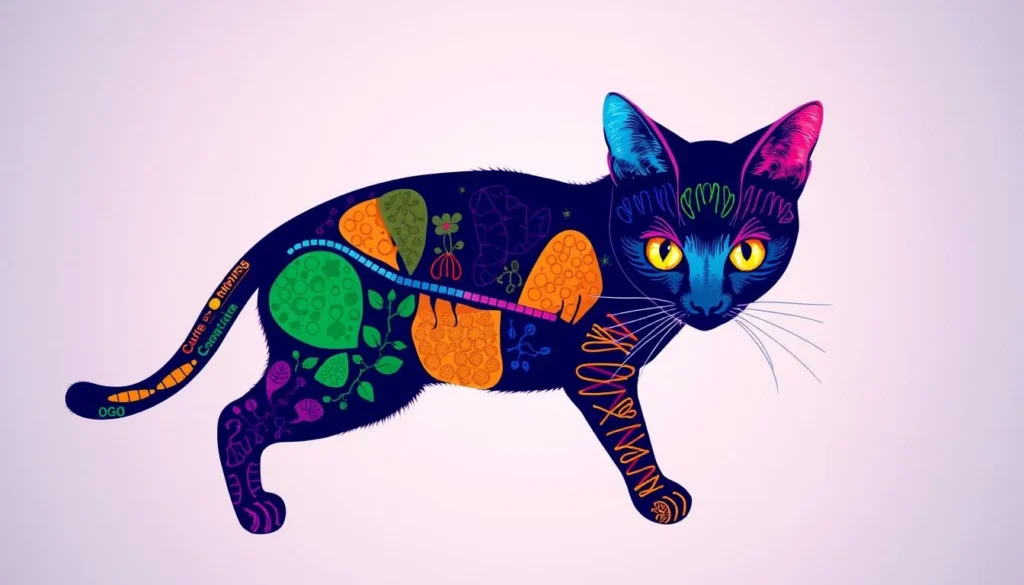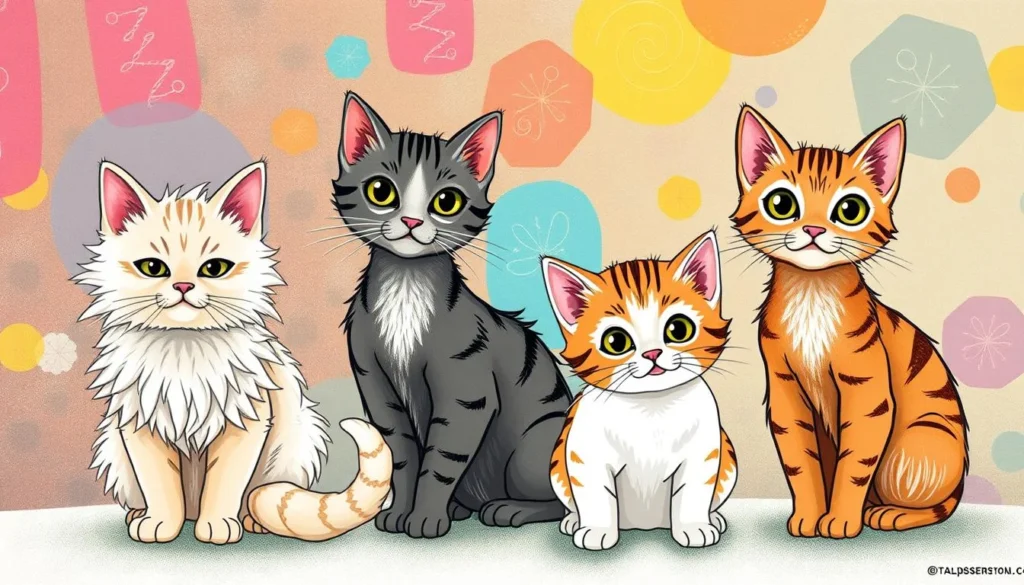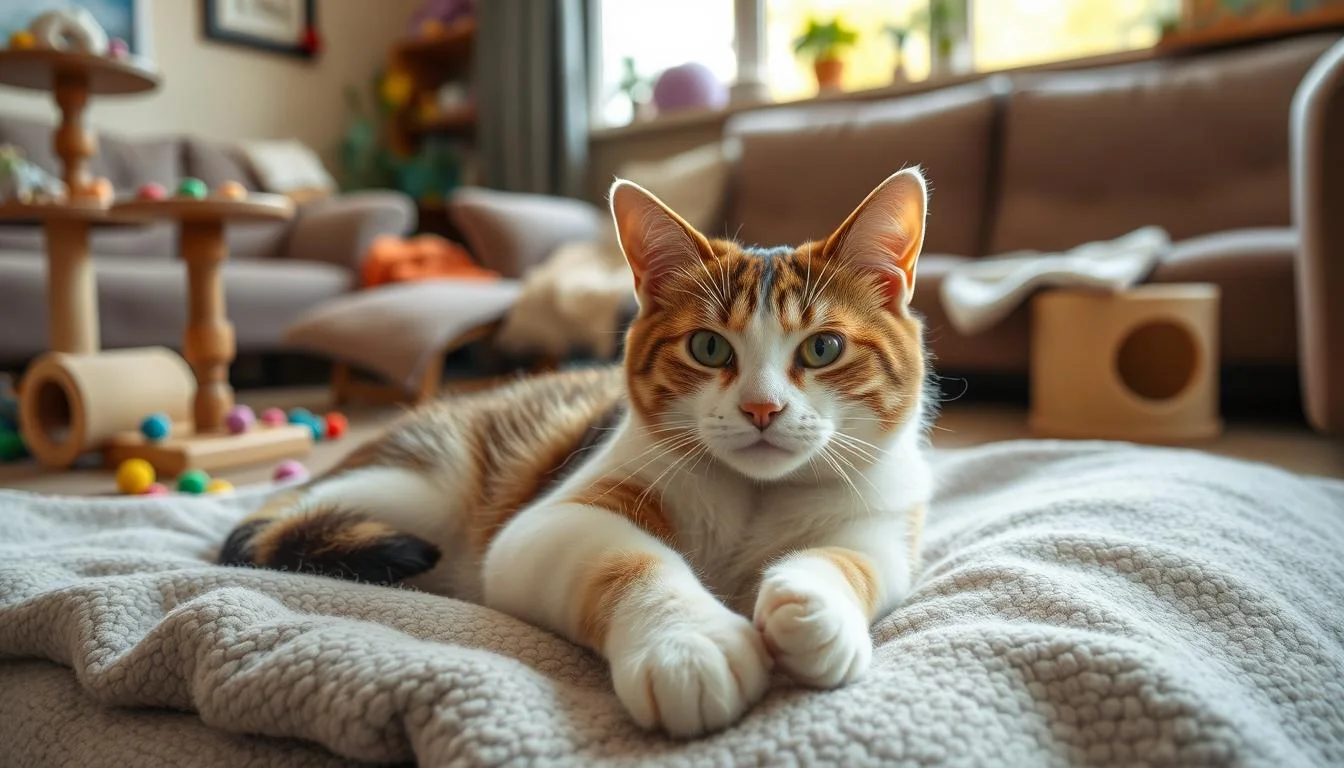Table of Contents
Every cat is special, but some need more care and understanding. When you meet a cat with unique traits, it’s normal to feel unsure. These cats, often thought to have Down syndrome, need our kindness and care.
It’s not about labeling cats with disabilities. It’s about seeing their unique qualities. While cats don’t have Down syndrome like humans do, some have traits that make them special friends.
Having a cat with special needs can be very rewarding. These cats teach us patience, love, and the beauty of differences. They show us that every life is valuable and worth loving.
Key Takeaways
- Cats can have unique genetic variations that impact their behavior and appearance
- Special needs cats require compassionate, individualized care
- Understanding is more important than diagnostic labels
- Each cat has a unique personality beyond possible genetic differences
- Professional veterinary guidance is key for their care
Understanding Down Syndrome Cat: Medical Facts and Reality
Genetic variations in cats can lead to unique traits. These traits might remind us of human genetic conditions. But, the truth about Down syndrome in cats is more complex than we think.

Genetic Foundations of Feline Chromosomal Differences
Cats have a unique genetic makeup that differs from humans. They have 19 pairs of chromosomes, unlike humans’ 23 pairs. This difference means that genetic issues show up in cats in unique ways.
- Humans have 46 total chromosomes
- Cats have 38 total chromosomes
- Down syndrome cannot occur in cats due to chromosomal structure
Genetic Disorders in Felines: Understanding the Complexity
Feline trisomy and chromosome abnormalities are complex for vets. Some conditions can look like Down syndrome, such as:
- Cerebellar hypoplasia
- Congenital developmental disorders
- Neurological variations
“Not all genetic variations are disorders; some are simply part of a cat’s unique genetic landscape.”
Scientific Research and Veterinary Perspectives
| Genetic Condition | Primary Characteristics | Potential Impact |
|---|---|---|
| Cerebellar Hypoplasia | Motor control challenges | Affects balance and coordination |
| Congenital Deafness | Associated with white fur/blue eyes | Potential sensory limitations |
| Chromosomal Variations | Unique physical traits | May require specialized care |
Understanding genetic disorders in cats needs careful vet work. Each cat’s genetic profile needs special care and compassion.
The Truth About Feline Genetic Disorders
Understanding genetic disorders in cats needs careful study and expert advice. Many think cats can have Down syndrome, but it’s more complicated. Feline genetic counseling shows how cats’ genes are different from ours.

Cats have 19 chromosome pairs, unlike humans’ 23. This big difference means genetic disorders show up differently in cats. Genetic variations can create unique challenges for cats.
“Not all unusual behaviors indicate a genetic disorder in cats.” – Veterinary Genetics Association
Some genetic conditions that can affect cats include:
- Turner’s syndrome
- Klinefelter’s syndrome
- Chimerism
- Cerebellar hypoplasia
Vets say to watch your cat closely and get a professional diagnosis if they act strangely or have growth issues.
| Genetic Condition | Prevalence | Key Characteristics |
|---|---|---|
| Feline Infectious Peritonitis | 25-40% in household cats | Potentially fatal viral infection |
| Cerebellar Hypoplasia | Rare | Impacts motor function development |
| Chromosome Variations | Less than 1% | Can affect behavioral and physical traits |
Regular vet visits and genetic tests can spot problems early. This ensures your cat gets the right care and support.
Recognizing Special Needs in Cats: Beyond the Label
Understanding cat disabilities needs careful watching and caring. Cats with special needs show unique traits. Knowing these signs can greatly improve their life.
Seeing special needs in cats is more than just labels. It’s about knowing their personal struggles and helping them.
Physical Signs and Symptoms
Look for these physical signs in cats with special needs:
- Unusual body movements or coordination challenges
- Persistent head tilting or balance issues
- Irregular gait or difficulty walking
- Sensory processing differences
Behavioral Indicators
Learning about cat health means noticing behavioral signs too:
- Extreme sensitivity to touch or sound
- Reduced social interaction
- Repetitive behaviors
- Difficulty responding to standard communication
“Every cat is unique, and understanding their individual needs is the first step in providing exceptional care.”
When to Consult a Veterinarian
Seeking a vet’s advice is key when symptoms persist. Schedule a vet visit if you see:
- Consistent changes in behavior
- Unexplained physical limitations
- Regression in previously learned skills
- Significant alterations in communication patterns
Early action can greatly enhance your special needs cat’s life and health.
Common Health Challenges in Cats with Special Needs
Caring for disabled cats means knowing their health challenges well. Veterinarians say cats with special needs have unique health needs. They need special care and attention.
Cats with developmental differences face many health issues. These issues can affect their life quality. With the right cat health education, owners can handle these problems better.
- Neurological conditions affecting coordination
- Mobility limitations
- Sensory function impairments
- Cognitive development variations
Feline genetic counseling is key in spotting health risks. Cats have 19 pairs of chromosomes. This means their genetic conditions are different from humans.
“Understanding your special needs cat’s unique health profile is the first step in providing exceptional care.” – Veterinary Specialists Association
Some common health challenges include:
- Cerebellar Hypoplasia: Causing uncoordinated movements
- Potential neural damage from early infections
- Low muscle tone affecting physical capabilities
- Increased vulnerability to environmental stressors
Managing your cat’s health needs a proactive plan. Regular vet visits, special diets, and care environments can help a lot.
Creating a Supportive Environment for Special Needs Cats
Caring for disabled cats needs careful planning and kindness. Your special needs cat needs a safe, comfy, and fun place. This place should meet their unique needs.
Understanding cat disabilities means making spaces for their challenges. The goal is to create a place that feels safe, comfy, and engaging.
Home Modifications and Safety Measures
When caring for disabled cats, safety is key. Here are some important changes:
- Install non-slip mats in high-traffic areas
- Create low-sided litter boxes for easy access
- Remove sharp edges
- Provide ramps or gentle steps for elevated spaces
Enrichment Activities and Stimulation
Mental stimulation is key for special needs cats. Keep them engaged with:
- Soft, interactive toys with different textures
- Gentle puzzle feeders
- Low-intensity play sessions
- Calming background sounds
“Every cat is unique, and special needs cats require extra patience and creativity.” – Veterinary Behavioral Specialist
Establishing Routines and Comfort Zones
Cat owner support groups stress the value of routines. Create special spots where your cat feels safe:
- Designate a quiet retreat area
- Maintain consistent feeding times
- Use familiar bedding and blankets
- Keep environment predictable
Your love and understanding can greatly improve your special needs cat’s life.
Daily Care and Management Strategies
Caring for disabled cats needs special attention and thoughtful plans. Your daily management can greatly affect your cat’s life quality and health. It’s important to understand their unique needs for the best care.
For cat health education, create a consistent routine that meets your cat’s needs. Here are key management strategies:
- Create a predictable daily schedule
- Design safe and accessible living spaces
- Monitor nutrition and weight carefully
- Implement gentle exercise routines
- Use specialized care techniques
Nutrition is key in managing your cat’s health. Weight management is very important for cats with limited mobility. Here are some dietary tips:
| Dietary Consideration | Recommendation |
|---|---|
| Caloric Intake | Adjust based on ideal weight, not current weight |
| Food Type | High-protein, nutrient-rich wet foods |
| Treat Limit | Maximum 10% of total daily calories |
“The right care can transform a challenging situation into a beautiful journey of companionship.” – Veterinary Nutrition Expert
Cat owner support groups offer great resources and emotional support. Connecting with others who get what you’re going through can help a lot.
Remember, patience, love, and consistent care are your strongest tools. They support your feline friend’s health and happiness.
Understanding Feline Behavioral Patterns
Cats talk in complex ways, not just with meows. Knowing about cat disabilities means understanding their special language. Studies show 77% of pet owners face behavioral issues with their cats, showing the need for cat health education.
Cats use body language, sounds, and subtle signs to communicate. Their ways of talking are detailed and often missed by humans.
Communication Methods
- Body postures showing emotions
- Tail movements showing mood
- Ear and whisker positions
- Different sounds with specific meanings
Social Interactions
For cats with special needs, socializing can be tough. Support groups for cat owners stress the need for patience and understanding.
| Interaction Type | Characteristic | Potential Challenge |
|---|---|---|
| Head Bunting | Affection and Scent Marking | Sensory Sensitivity |
| Kneading | Comfort Behavior | Overstimulation Risk |
| Grooming | Social Bonding | Potential Anxiety |
Stress Management Techniques
Managing stress in cats needs a variety of steps. Knowing what stresses them and making a calm space are key to their well-being.
“Cats are masters of adaptation, but they need our understanding and support.” – Feline Behavior Expert
Adding enrichment to their environment helps reduce stress. Safe spots, regular routines, and gentle touch make cats feel safe and happy.
- Create quiet retreat areas
- Use pheromone diffusers
- Maintain consistent daily schedules
- Minimize sudden environmental changes
By learning more about cat behavior, you can build a better bond with your special needs cat.
Building a Support System: Resources and Communities
Dealing with special needs cats needs a strong support network. Cat owner support groups are key in giving emotional and practical help. They offer resources and understanding that help make caring for your cat easier.
- Online forums dedicated to special needs cats
- Local support groups in your community
- Veterinary professional networks
- Feline genetic counseling services
“No one understands the challenges of caring for a special needs cat better than those who have walked the same path.” – Veterinary Support Network
Learning about cat health is key to caring for your special cat. Many organizations provide important resources:
| Organization | Key Services |
|---|---|
| National Feline Health Association | Educational webinars, support resources |
| Special Needs Cat Support Network | Community forums, expert consultations |
| Feline Genetic Research Center | Counseling, genetic disorder information |
Your support system is more than just a network—it’s a lifeline. It’s filled with knowledge, compassion, and practical help. By connecting with others who get what you’re going through, you’ll find strength and guidance in caring for your special needs cat.
Essential Medical Care and Veterinary Support
Caring for disabled cats needs a full plan for vet support. Feline genetic counseling helps understand your cat’s health challenges. Regular vet visits are key to keeping your cat healthy and catching problems early.
“Early detection and proactive care are the keys to managing your cat’s health effectively.”
Your vet care plan should include:
- Annual wellness exams for adult cats
- Biannual check-ups for senior cats
- Comprehensive early detection profiles
- Complete blood count (CBC) testing
- Thyroid function assessments
Special vet support is vital for cats with genetic or developmental issues. Find vets who know about cat health and special needs cats. They can give targeted treatments and make care plans just for your cat.
The American Animal Hospital Association (AAHA) suggests a whole approach to cat health. This includes:
- Preventive parasite control
- Regular dental care
- Nutrition management
- Weight monitoring
- Behavioral assessments
New treatments and therapies help us care for disabled cats better. They offer hope and a better life for these special friends.
Conclusion: Embracing and Supporting Special Needs Cats
Understanding cats with special needs is a journey of compassion and dedication. Your commitment to caring for a down syndrome cat or any feline with unique challenges can transform both your life and the cat’s quality of life. Support from cat owner support groups can provide invaluable resources and emotional connection during this experience.
Caring for cats with special needs requires patience, adaptability, and a deep understanding of their individual requirements. Research shows that environmental modifications and tailored behavioral approaches can significantly reduce stress and enhance their overall well-being. By creating structured, predictable environments, you can help your special needs cat thrive and feel secure.
The bond between humans and special needs cats is profound. While these felines may face unique challenges, they possess remarkable resilience and capacity for love. Connecting with veterinary professionals, joining supportive communities, and continuously educating yourself about cats with special needs will enable you to provide the best possible care and create a nurturing home environment.
Your willingness to open your heart and home to a cat with special needs is an act of extraordinary compassion. Remember that every cat is an individual with the ability to bring joy, companionship, and meaningful connection. By approaching their care with empathy and dedication, you can make a significant difference in their life.
